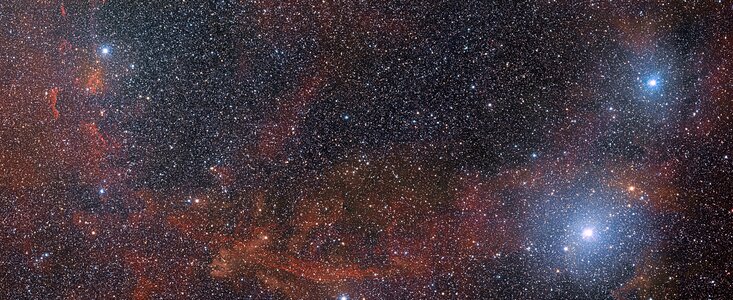Supernova From the Year 185: A Rare View of the Entirety of This Supernova Remnant
Dark Energy Camera captures the glowing remains of the first-ever documented supernova
1 March 2023
The tattered shell of the first-ever historically recorded supernova was captured by the US Department of Energy-fabricated Dark Energy Camera, which is mounted on the National Science Foundation’s (NSF) Víctor M. Blanco 4-meter Telescope at Cerro Tololo Inter-American Observatory in Chile, a Program of NSF’s NOIRLab. RCW 86’s ring of debris is all that remains of a white-dwarf star that exploded more than 1800 years ago, when it was recorded by Chinese stargazers as a ‘guest star’.
Draped around the outer edges of this star-filled image are wispy tendrils that appear to be flying away from a central point, like the tattered remains of a burst balloon. These cloud-like features are thought to be the glowing remains of a supernova that was witnessed by Chinese astronomers in the year 185 C.E. When it appeared, this baffling addition to the night sky was referred to as a ‘guest star’ by ancient astronomers. It remained visible to the naked eye for about eight months before fading from view.
This historical supernova, which astronomers now refer to as SN 185, occurred more than 8000 light-years away in the approximate direction of Alpha Centauri, between the constellations of Circinus and Centaurus. The resulting structure, RCW 86 — as imaged by the Dark Energy Camera (DECam) mounted on the Víctor M. Blanco 4-meter Telescope at Cerro Tololo Inter-American Observatory in Chile, a Program of NSF’s NOIRLab — helps shed light on how the remains of the supernova evolved over the past 1800 years. DECam’s amazing wide-field vision enabled astronomers to create this rare view of the entire supernova remnant as it is seen today.
Though the link between RCW 86 and SN 185 is now well established, that wasn’t always the case. For decades, astronomers thought it would take about 10,000 years for a traditional core-collapse supernova — one in which a massive star blows material away from itself by exploding — to form the structure as we see it today. This would make the structure far older than the supernova observed in the year 185.
This preliminary estimate largely came from measurements of the supernova remnant’s size. But, a 2006 study found that the large size was due instead to an extremely high expansion velocity. The new estimate is much more in line with a comparatively youthful age of about 2000 years, which strengthened the link between RCW 86 and the guest star observed centuries ago.
While a more accurate age estimate brought astronomers one step closer to understanding this unique stellar feature, one mystery still remained. How did RCW 86 expand so fast? The answer was uncovered when X-ray data of the region revealed large amounts of iron present, a tell-tale sign of a different kind of explosion: a Type Ia supernova. This type of blast occurs in a binary star system when a dense white dwarf (the end-of-life remains of a star like our Sun) siphons material from its companion star to the point of detonation. These supernovae are the brightest of all and no doubt SN 185 would have awed observers while it shone brightly in the night sky.
Astronomers now have a more complete picture of how RCW 86 formed. As the white dwarf of the binary system swallowed the material of its companion star, its high-velocity winds pushed the surrounding gas and dust outward, creating the cavity we observe today. Then, when the white dwarf could not support any more mass falling onto it from the companion star, it exploded in a violent eruption. The previously formed cavity gave ample room for the high-velocity stellar remnants to expand very quickly and to create the monumental features we see today.
This new image of RCW 86 gives astronomers an even deeper look into the physics of this perplexing structure and its formation.
The image was obtained by NOIRLab’s Communication, Education & Engagement team as part of the NOIRLab Legacy Imaging Program.
More information
NSF’s NOIRLab (National Optical-Infrared Astronomy Research Laboratory), the US center for ground-based optical-infrared astronomy, operates the international Gemini Observatory (a facility of NSF, NRC–Canada, ANID–Chile, MCTIC–Brazil, MINCyT–Argentina, and KASI–Republic of Korea), Kitt Peak National Observatory (KPNO), Cerro Tololo Inter-American Observatory (CTIO), the Community Science and Data Center (CSDC), and Vera C. Rubin Observatory (operated in cooperation with the Department of Energy’s SLAC National Accelerator Laboratory). It is managed by the Association of Universities for Research in Astronomy (AURA) under a cooperative agreement with NSF and is headquartered in Tucson, Arizona. The astronomical community is honored to have the opportunity to conduct astronomical research on Iolkam Du’ag (Kitt Peak) in Arizona, on Maunakea in Hawai‘i, and on Cerro Tololo and Cerro Pachón in Chile. We recognize and acknowledge the very significant cultural role and reverence that these sites have to the Tohono O’odham Nation, to the Native Hawaiian community, and to the local communities in Chile, respectively.
Contacts
Charles Blue
NSF’s NOIRLab
Cell: +1 202 236 6324
Email: charles.blue@noirlab.edu
About the Release
| Release No.: | noirlab2307 |
| Name: | RCW 86 |
| Facility: | Víctor M. Blanco 4-meter Telescope |
| Instruments: | DECam |





